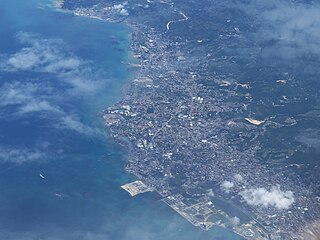
Cebu, officially the Province of Cebu, is a province of the Philippines located in the Central Visayas (Region VII) region, and consists of a main island and 167 surrounding islands and islets. Its capital and largest city is Cebu City, nicknamed "the Queen City of the South", the oldest city and first capital of the Philippines, which is politically independent from the provincial government.

Cebu City, officially the City of Cebu, is a 1st class highly urbanized city in the Central Visayas region of the Philippines. It is the capital of the Cebu Province, where it is geographically located but is one of three cities that are administratively independent of the provincial government. According to the 2020 census, it has a population of 964,169 people, making it the sixth-most populated city in the nation and the most populous in the Visayas.

Metropolitan Cebu, or simply Metro Cebu,, is the main urban center of the province of Cebu in the Philippines. Metro Cebu is located along the central eastern portion of the island including the nearby island of Mactan. It accounts for 19.9 percent of the land area and 61.5 percent of the population of the entire province of Cebu.
Leo Andanar Lastimosa is a veteran tri-media journalist based in Cebu City, Philippines. He was formerly an anchorman for ABS-CBN's regional news program, TV Patrol Central Visayas, the host of the current affairs program Arangkada on radio station DYAB, and a columnist for Cebu's newspaper, The Freeman.

Gwendolyn Fiel Garcia is a Filipina politician serving as the governor of Cebu since 2019, a position she previously held from 2004 and 2013—being the first woman to hold that office. She was the representative of Cebu's 3rd congressional district from 2013 to 2019 and concurrently served as a House Deputy Speaker from 2016 to 2018.

Thriller is a viral video featuring the CPDRC Dancing Inmates of a high-security penitentiary. In 2007, the inmates of Cebu Provincial Detention and Rehabilitation Center (CPDRC), a maximum security prison in Cebu, the Philippines, imitated the zombie dance featured in the music video of Michael Jackson's "Thriller". The footage, uploaded onto video-sharing website YouTube, became a viral video. The idea behind the dance came from the prison's chief, Byron F. Garcia. Garcia first conceived the idea of exercising as an enjoyable way of keeping the prisoners mentally and physically fit. Music was then added to provide additional motivation. The convicts marched and danced to several songs, including "In the Navy" and "Y.M.C.A." by the Village People.

The National Museum of the Philippines is an umbrella government organization that oversees a number of national museums in the Philippines including ethnographic, anthropological, archaeological, and visual arts collections. From 1973 until 2021, the National Museum served as the regulatory and enforcement agency of the government of the Philippines in the restoring and safeguarding of significant cultural properties, sites, and reservations throughout the Philippines. The mandate has since been transferred to the National Commission for Culture and the Arts.

National Museum of the Philippines – Cebu is a museum in Cebu City, Philippines under the National Museum of the Philippines system.
CPDRC Dancing Inmates or the CPDRC dancers is a collective of prison inmates in Cebu Provincial Detention and Rehabilitation Center (CPDRC), a maximum security prison in Cebu, in Cebu Province, Philippines where the prisoners perform dance routines as part of their daily exercise and rehabilitation, and many of their performances are filmed and released online, making them a popular feature among fans and veritable online celebrities.
Cebu Provincial Detention and Rehabilitation Center (CPDRC) is a jail facility in Cebu, in Cebu Province, Philippines. It is a maximum security facility with a capacity for 1,600 inmates.

Central Visayas is an administrative region in the Philippines, numerically designated as Region VII. It consists of four provinces: and three highly urbanized cities: Cebu City, Lapu-Lapu, and Mandaue).

Mactan–Cebu International Airport is an international airport serving Cebu and serves as the main gateway to the Central Visayas region in the Philippines. Located on a 797-hectare (1,970-acre) site in Lapu-Lapu City on Mactan, it is the second busiest airport in the Philippines. Opened on April 27, 1966, the airport serves as a hub for Philippine Airlines, and as an operating base for Cebu Pacific and Philippines AirAsia.

Vicente Rama was a Filipino Visayan legislator, publisher, and writer from Cebu, Philippines. Recognized as the Father of Cebu City, he authored the bill for its cityhood which was approved into law by October 20, 1936. He also founded the leading pre-war Cebuano periodical, Bag-ong Kusog.
Sotero "Terong" Barte Cabahug was a Filipino lawyer, legislator, politician, and civil servant from Mandaue, Cebu, Philippines. He was awarded Legion of Honor with the rank of Commander. He was governor of Cebu (1934–1937), member of the House of Representatives for Cebu's 2nd district for two consecutive terms (1928–1934), Secretary of Public Works and Communications (1945–1946), member of the Cebu Provincial Board (1952–1954), the 9th Secretary of National Defense (1954–1956), and associate justice of the Court of Appeals (1956–1961).
Vicente "Tingting" Low de la Serna was a Filipino lawyer, politician, and legislator. He was Cebu's 6th district's representative to the 8th Congress of the Philippines (1987–1992) and the governor of the province of Cebu, Philippines from 1992 until 1995.

Rizal Memorial Library and Museum is a three-story, pre-war, neoclassical heritage site and landmark in Cebu City, Philippines. Dedicated to the national hero, Jose P. Rizal, it was designed by Filipino architect Juan M. Arellano, who also designed the Cebu Provincial Capitol building. Inaugurated in 1939, the building survived World War II. It is located along Osmeña Boulevard and houses the offices of Cebu City Tourism, the Cultural and Historical Affairs Commission, the Sinulog Hall on the third floor, the Cebu City Museum of Visual Arts on the second floor, and the Cebu City Public Library on the ground floor.

The Manila City Jail, popularly known as Old Bilibid Prison, is a detention center in Manila, Philippines. The jail is one of the most overcrowded in the world.

"Mabuhi!" ; cf. "mabuhay"), also known as "Mabuhi Ka, Sugbuanon", is a song written and composed by Filipino musician Paul Melendez. Often played and danced to at festivals throughout the province of Cebu, including at the Sinulog Festival, it is the signature song of the administration of Gwendolyn Garcia as the Governor of Cebu.

The Iloilo Customs House is a historical building in Iloilo City, Philippines. It was built in 1916 to a design by American architect Ralph Harrington Doane, then Consulting Architect of the Bureau of Public Works in the Philippine Islands. Among the three American-era customs houses in the Philippines, it is the second largest and second oldest. The building is located at Muelle Loney Street and Aduana Street along the Iloilo River and still houses the offices of the Bureau of Customs and the Bureau of Immigration in Iloilo City.

The National Museum (NM) Western Visayas Regional Museum, simply known as the National Museum Western Visayas, is a museum in Iloilo City, Philippines.

















